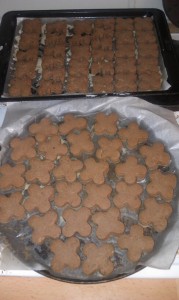At the end of another ABC program, I saw a short item from 2004 called Wicked about chefs’ favourite dessert recipes. It had actor and food author Vincent Schiavelli telling about a recipe from one of his friends back home in Sicily. It’s in a book of his “Many Beautiful Things”. The recipe is also at http://www.lifestylefood.com.au/recipes/10987/crostata-i-miennuli-almond-pie. It’s a shortcrust pastry with marmelade at the bottom then topped with an almond paste filling, and blanched almonds on top. So, this is a Sicilian recipe (almonds were introduced there about 1200 years ago from the Orient and have spread as far as Scandinavia since).
Now what’s really intreresting is variations of this pie are very common in The Netherlands for food around the time of St.Nicholas (early December). I can buy it at the local Dutch shop, but as you know I try to cook most things myself these days, so I know how it’s done. I know of two main variations, one is “filled speculaas” which is essentially two layers of gingerbread (with lots of cinnamon and cloves added) with an almond past filling in between. But the other one is more interesting: a roll of pastry, with almond filling inside, and generally on top: marmelade, blanced almonds, and optionally glace cherries. The shape is either a stick (resembling the staff of St.Nick) or curved in to an S (for Sint). It’s called a “banketstaaf” or “banket letter”. But isn’t the resemblance of these recipes remarkable… it’s like the pie has been adapted into another shape for the festive purpose!
By the way, it’s completely yummie. Not least, of course, because it’s full with sugar and butter, not to forget the almonds ;-)
And on that note, when I first made the stick recipe and ate some straight out of the oven, it tasted different from what I was used to. When I’d let it cool and warmed it again later to have more, it tasted exactly like I remembered from NL. So whatever I’d ever bought before had never been “fresh” out of the oven. Funny. But, the cooled-reheated actually does taste better! And guess what, the pie instructions also note that you should leave it cool/rest for about a day after baking. So there you go.
I don’t yet know how this fits in terms of the etymology of the Sinterklaas recipes, but there’s bound to be a connection somewhere…

